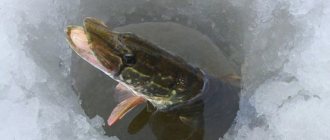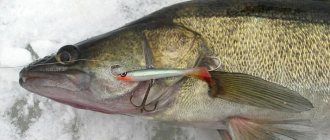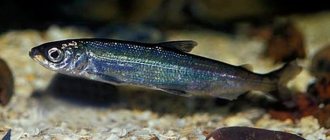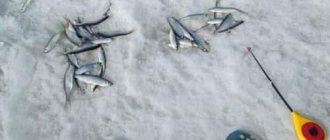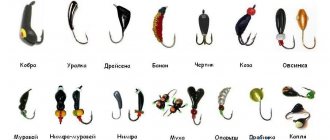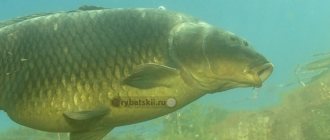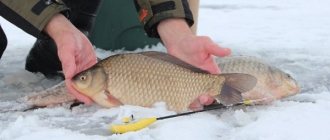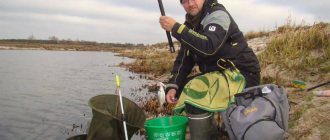Arthur Gabdrashitov, St. Petersburg | March 30, 2021
Winter spinners with a hook soldered into the body are popularly called “soldered in”. Our grandfathers used to catch perch well with them, and modern hooks are even more effective. In this article I will share my experience of mastering fishing with them.
On Ladoga and the Gulf of Finland, the best way to catch perch is by soldering. And although they don’t always bite on soldered baits, their main advantage over balancers and spinners with a hanging hook is that they attract striped fish better. And the speed of catching schooling perch is the highest, because you can catch fish in a matter of seconds.
With soldering, one successful hole per day can yield a larger catch than many neighboring fishermen. And for the spinner, it is a special pleasure when the bite is transmitted by a blow to the hand, which is what happens when the perch bites on the solders.
St. Petersburg fishermen have classic models of spinners in their arsenals: three-edges, including “pregnant” ones (photo 1), “diamonds”, “sleepers”, etc. A couple of years ago I learned about soldering joints of a different shape; they are produced by St. Petersburg master Anton Malyugin.
We are talking about his Ripus lures of different sizes (photo 2). Among the perch spinners with suspended tees, there are many catchy baits with a similar expansion at the top (photo 3) - ours and Finnish ones. But this is the first time I’ve seen soldering with exactly this shape. By the way, these spoons have a proprietary know-how that increases catchability - small bead pendants, as well as a coating on the bottom of the spoon that glows in ultraviolet and in the dark.
In fact, this is the point of attack, which is especially effective at great depths or in turbid water (photo 4).
On my first fishing trip on Ladoga I caught a Ripus 70 mm long (photo 5). Back then, my friend and I only put spinners and balancers on the fishing line. In the crowd nearby, some people caught a single fish using jigs, others managed to catch several striped fish using balance beams, but only in the early morning. We took proven spoons, wandered around the crowd of fishermen for half a day, but did not catch anything. After lunch, the bite in the crowd completely disappeared, the fishermen became quiet and stopped running.
The friend wandered towards a distant group of fishermen to look for his fish. And I stepped away from the crowd and began experimenting with soldering. At first I fished with Ripus-80 - more precisely, I simply experimented with the game. At a depth of about 2.5 m, ten minutes later someone touched the spoon at the bottom, and another two or three minutes later, after a couple of idle bites, a perch was caught somewhere in the water. Having received a couple more unfulfilled bites, I thought a little - and installed a Ripus-70 solder. I lowered the spoon, after the first stroke I caught a perch, and then another and another. I haven’t seen such a greedy bite for a long time.
The fish swallowed the spoon almost halfway, but retrieving the bait was easy and quick - and I immediately lowered the bait into the hole behind the next perch. I waved with a solder and hooked in the same way as before I caught with a balancer, and on the descents and idle strikes I lost about the same amount of fish as I caught. True, I managed to fish calmly for about 15 minutes, then I was surrounded by fishermen - and the bite immediately stopped. A friend caught 5 perches all day: one on a balance beam, the rest on a “fly” hung above it.
Most of the surrounding fishermen also had small catches. My first impression of soldering remained contradictory - the excitement from the crazy bite was mixed with disappointment from the number of failures. Then, at home, I learned on the Internet a simple technique for fishing with such solders - and on the very next fishing trip there were fewer incidents, and the fishing speed increased.
Since then, I have been successfully fishing with this Ripus on Ladoga, for two seasons already, alternating it with other baits, and on the Gulf of Finland I have used Ripus 90 and 100 mm long.
Equipment for soldered spinners
For soldering, I take fishing rods with a whip 35 - 50 cm long, comparable in rigidity to the tip of a spinning rod with a test of up to 40 - 50 g. Remember the length of your whip and measure the height to which you can lift the whip from the bottom position to top. This will help you navigate when playing vertically. A long whip is more convenient for different playing techniques; it better absorbs the jerks of the fish after hooking, but it is more difficult to maintain during transportation. For ease of transportation, fishing rods are made with a telescopic whip. But fishing rods with solid whips are stronger and more reliable.
Ripus spinners up to 90 mm in length, it is recommended to use a line with a diameter of 0.25 - 0.28 mm, and for larger models - 0.3 mm. I personally use two lures, one of which is wound with 0.25 mm fluorocarbon for fishing at depths of more than five meters, and the other with monofilament with a diameter of 0.28 mm for shallower depths. For small solders up to 5 cm long there is a rod with 0.2 mm fluorocarbon.
Winter lures for perch, pike and pike perch
Winter spoons, like summer ones, are made of metal in the form of streamlined and elongated plates. You need to know that the predator only notices the bait that makes rhythmic movements in the water. Erratic movements also attract the attention of the fish, but the deception quickly dawns on it.
In winter, the object of fishing is perch, for which small narrow spoons are used; they give good results. Pike and pike perch are caught in the same way. After hooking, the large fish is removed from the water by reeling in the fishing line by hand.
- Perch is caught on small spoons, approximately 25 mm long and 6-8 mm wide.
- Spoons for pike come in 35-60 mm lengths, which are used with metal leads and well-sharpened tees.
- Zander spoons are narrower than pike spoons, but the same length, with dimensions of 6-10 mm in width and 30-60 mm in length, in light silver tones.
How to play with a spinner?
You can play in the same way as with balancers and spinners with a hanging hook - this is when the spinner is thrown with swings with an amplitude of 20 - 50 cm with pauses between throws of 2 - 5 or more seconds. But there are specific playing techniques that allow you to 100% realize the strengths of soldering.
The first technique is the “short jerk”. It looks like this: the whip occupies the clockwise position at 6-30 - 7-00 (in photo 6 - focusing on the 12-hour dial). With a sharp short swing, the whip is moved to a position of approximately 7-30 - 8-30 and returns back. The spinner glides upward and to the side during the swing; after a jerk to the side, it stops at the top point, and an arc of the fishing line is formed.
Then the spoon flies down and to the side, as long as the fishing line is enough, then it stops, and we feel the striker through the rod. Many long and massive solders (for example, the same Ripus 90 - 110 mm) with such a game plan upwards and to the side, then you feel a weak blow through the fishing rod, and the second time the blow comes after planning the spoon down all the way.
Many spinners with a suspended tee often overlap due to sharp and short strokes, clinging to the fishing line with a hook, and for soldering, a “short tug” is one of the main techniques of the game.
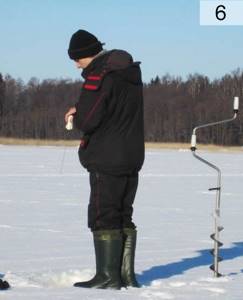
The second technique is to play without pauses. Active perches often grab the solder “in flight”, i.e. at the planning stage to the side when falling, when you throw it down a meter to one and a half meters when playing from top to bottom (photo 7), or when you throw the spoon high during the game. Try from time to time to play the spoon at a distance of 50 - 60 cm from the bottom with strokes of 60 or more centimeters without pauses.
Such a game, if it does not lead to a bite, will most likely attract the attention of active perches. And if after three to four minutes of such a game there are no bites, change the game; often at this change the gathered perches begin to be caught. A similar technique - playing without pauses and with a very short and sharp swing - is used for balance beams, but there it works much less often.
The third technique is vertical play. Use vertical up and down play more often; it is especially effective with soldering. It is necessary to make short and sharp strokes, after which the fishing rod returns to its previous position. Raising or lowering the spinner can be done in two ways.
The first - after swinging the whip 40 - 60 cm, it returns to its previous position, and when the spoon returns to the impact, it is raised or lowered by about 10 - 15 cm in 3 - 5 seconds, then stopped for a second or two. And then - a new upward swing.
The second - after swinging 50 - 60 cm, the whip stops 20 - 30 cm higher or lower, then a second pause follows.
More often it bites with the first option - when the spinner slowly moves vertically during a pause, but to better tease the fish, it is advisable to alternate playing techniques.
The fourth technique is a high swing and a long pause. Take long spinners that deviate to the side as much as possible during the game (I have Ripus from 8 - 9 cm long). Having lowered the spoon to the bottom, reel in the fishing line so that when the fishing rod is in working position, with the whip down, the spoon touches the bottom and is tilted approximately 45° to the vertical axis. Make a smooth upward swing about 1.5 m, then drop the spoon and lower the whip down exactly to the original level.
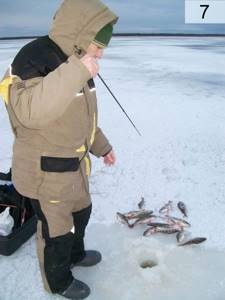
Wait for the spoon to play back and the line to deviate, and then, when the spoon returns to the center of the hole, you can shake the tip of the whip a little so that the spoon touches the bottom and raises clouds of turbidity. Then the line will stop and the spinner will freeze. After a pause of a second or two, repeat the swing and play. Make 3 - 4 such strokes, where the spoon will play at the very bottom, and then make the next stroke so that your spoon passes just above the bottom. To do this, after resetting, lower the fishing rod 10 - 15 cm above the previous level. After a pause of one to two seconds, perform the vertical lifting game again.
The fourth technique works best with soldered baits, because their hooks are bent upward and they weakly cling to the bottom when touched when the spoon returns to the center of the hole.
Loop for tying a spinner
The designs of loops for tying a homemade winter lure to a fishing line are shown in the photograph.
The hinges shown above are used to create an articulation between the hook and the body of the spoon.
The loops in the lower position of the photo are used to tie a winter lure to the fishing line. But nothing bad will happen if the loops are swapped.
Loops for soldering into baits can be bent from copper or annealed steel wire about 1 mm thick.
Shown below are round loops designed for tying homemade winter lures to fishing lines. Their ends are twisted.
A loop with an end twist for large homemade jigs and winter spinners can be made by bending the wire around one of the “jaws” of pliers or a nail of a suitable diameter.
True, I rarely solder loops of a similar design into the “tails” of my homemade winter spinners, since during final processing the twist turns begin to protrude from the solder poured onto the tail end of the homemade winter spinner. Therefore, the bait loses its presentation.
For tying homemade winter lures to a fishing line, round loops, shown in the photo in the top position, or rectangular loops are better suited. If necessary, single hooks, doubles, tees are inserted into the loop rings, in case they need to be hinged with the “nose” of a homemade winter lure.
To quickly attach a ready-made winter homemade spinner to a fishing line with a loop-to-loop knot, the most convenient are copper loops, not round, but elongated rectangular in shape, which can be formed by bending the wire around one of the “sponges” of the platypuses.
For the same purposes, you can make a template by riveting a nail of a selected diameter. I wire the puddle until the loops bend. In the photographs, the loops of homemade winter lures are presented in an untinned form.
Selection of catchable soldering
Many St. Petersburg spinners believe that in the Gulf of Finland it is better to catch with copper-silver spoons, and on Ladoga - with golden-silver ones. In my practice, following these color schemes did not increase catchability in any way; the shape, size and play of the spoon were more important.
Selecting the type of shape and size of the spinner. It’s easier to choose a soldered bait for a specific fishing location if you focus on individual fishing for predatory perch, rather than trying to shine in a crowd with jig lovers, where any bait bites poorly.
When fishing on Ladoga, you must first determine the size of the spinners with which you will fish in a particular place. It’s easiest if you’ve already fished here with lures with hanging hooks and you know approximately the size of catchable baits. Or someone will successfully lure next to you - and you may notice the size of his bait.
If there are no such hints, then keep in mind that for most places on Ladoga, solders with a length of 7 and 9 cm are catchable. In shallow waters (depth up to two meters), the working length is usually 5 cm. In the deep-water areas of Ladoga, where smelt and There are depths beyond 6 m; spinners with a length of 9–11 cm are often effective.
For the Gulf of Finland, it is easier to choose a spinner; there, the most universal are soldered ones with a length of 9 cm, although on the southern coast sizes of 10 and 11 cm also work well. But on both Ladoga and the Gulf of Finland, start exploratory fishing with the largest size spinner for a given depth and location . If it doesn’t bite in four or five holes, change the shape of the spoon. If there is no bite for all types of spinners of this size, try to choose shorter spinners.
If a single fish was caught with some spinner after uncertain bites, but the bite and fishing did not improve in the future, change the shape of the spinner again, but sticking to the configuration of the bait that got the bites.
Selection of spinners by shape and width. First, try looking for fish with wide spoons; they are better at collecting and catching single fish. To catch a schooling perch during an active bite, you need skill so that the spinner plays with a smaller amplitude.
Then try “Rombik” (photo 8). Such spoons with a length of 9 - 10 cm are good for fishing in the Gulf of Finland, and 6 - 7 cm models are suitable for Ladoga.
Sometimes on Ladoga and often on the Gulf of Finland, perch is caught using narrow spoons of the “Sleeper” type (photo 9). For Ladoga, the universal size of this bait is 8 cm, for the Gulf of Finland – 11 cm.
Horizontally submersible spinners
This type of spinner is a relatively recent invention. It began to be widely used only in recent decades. These baits are metal spinners of various configurations with the fishing line attached not to the end, like vertical and other spinners, but to the middle of their side. Such fastening, even for figures that are not very streamlined, encourages energetic lateral movement when lowered into the water. A spoon located in the water column in a horizontal plane can, with skillful guiding, perform difficult movements in a circle. Horizontally plunging spoons are produced as symmetrical (“rocker arms”) and asymmetrical. Symmetrical lures are used much less frequently than asymmetrical ones, since their play in the water column is not so varied.
Fishing with horizontal spoons also needs to be learned. They usually start with a pendulum movement from edge to edge of the hole. Then they master the move in a circle. This type of wiring - in a circle - is the main one for horizontal spinners. Typically, the angler takes advantage of several fishing options in a closed circle that bring the best results. The bait is led in a circle, changing the direction and depth of the retrieve depending on the angler’s ability to make such movements. A remarkable effect is achieved by following the line of movement in the form of a narrow figure eight, with the sides lying at different depths.
Horizontal spoons, like many other artificial baits, are used both with and without baits. Excellent results are obtained by combining these spinners with a jig. Its combination with the “devil” has become especially famous. Horizontal spoons give a good effect when catching burbot. This predator usually grabs the prey crosswise and only after squeezing it begins to swallow. The transverse spinner guarantees a hook, which does not always happen when using conventional spinners with the end location of the hooks. There are designs made by amateurs on their own, reminiscent of a veiled-tailed guppy. These are brightly decorated “fish”, one of the hooks of which is camouflaged with beautiful long plumage made of multi-colored threads. Bright colors are generally characteristic of horizontal spoons, which because of this resemble artificial foam fish.
Solder fishing tactics
The noise of the crowd, where they fish with jigs and “reelless” ones, does not frighten inactive perches. Also, small perches that are caught on small balancers or spoons are not afraid of it. But large perch are more careful. Therefore, when flashing by soldering, it is better to move away from the crowd. There were many cases when a partner or other anglers in one way or another created noise within a radius of 20 - 30 m from me - and the bites became uncertain, the perch moved away from the hole, and even at a catching point, the bite could resume 15 - 20 minutes after the noisy actions. In general, try to fish according to the principle “the further away from the crowd of anglers, the better.”
When trolling at depths of up to 4 - 5 m, try to stay at least two hundred - three hundred meters away from this very crowd (photo 10). And do not get closer to single fishermen than 40 - 50 m. When searching for fish collectively with friends, keep the distance between you at least one hundred meters.
Spinning rod for catching trophy predators
Seika Pike Killer series offers medium-fast spinning rods with a high reliability threshold.
The blank is made using IronTech technology - a synthesis of carbon materials with different levels of modularity, which ensures high power of the blank while maintaining its lightness. The reinforced lower part of the spinning rod guarantees additional strength to the rod. The elastic tip with good sensitivity allows you to instantly feel the bite. The blank is equipped with Sea Guide SiC inserts and a “tulip” to prevent line overlap.
An ergonomic handle made of rubberized neoprene with cork inserts and a classic screw reel seat with an anti-vibration system are installed.
If you are looking for fish without an echo sounder (and with an echo sounder you can find a perch, pick up a lure and start fishing several hours faster than without it) - the most common scenario for fishing with solders on new holes is this: a long game waiting for a bite, and then a quick fishing. With soldering, you need to get used to fishing the holes a little longer than with a balancer and a spoon.
In the excitement of the beginning of the bite and out of habit, many fishermen forget that by soldering in two to three minutes they knock out the most active perches, and the remaining ones rise a little higher. Accordingly, you should get used to reeling the fishing line 15 - 30 cm higher after catching several perches.
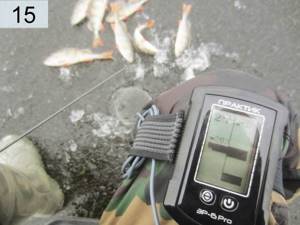
When, after dropping the spoon, the entire working part of the fishing line goes into the hole to the same depth or a little higher, pause for 5 to 10 seconds, depending on the fishing depth. It has been noticed that baits - unlike other winter baits - catch perch at these moments. When hunting for low-active perch with a small and light solder, when returning the spoon to the center of the hole, the bite can be almost imperceptible - the spoon just seems to stop. When you drop the lure into the hole, during a pause, just watch the line as it returns to the center of the hole - and then you can see how the line freezes in an inclined position due to the grip of the perch.
If you are quickly catching a school of perch, the spoon can not only collect the fish, but also disperse the nearest perches due to sharp gliding deviations to the sides or turning the fish purple, so if you get caught in a school, play the spoon with short strokes of 3 - 4 - 5 cm, they will also replace cuttings. This is where you need a hard whip that will transfer the desired play to the lure without bending.
When trolling perch, a wrist stroke with a fishing rod replaces hooking.
If a whip with a length of 35 cm was lowered almost vertically down, then when you put it straight up, your spoon will rise by about 60 - 70 cm. Having felt the weight of the hooked fish, you can continue lifting and fishing.
If after the bite you do not detect anyone, then pause for a second without lowering the spoon. The perch can catch up with it and peck. If it doesn’t bite, toss the spoon from the top position and drop it, raising your hand 20 - 30 cm, then continue playing again with short strokes of 3 - 4 cm. This technique will reduce the number of trips and increase the catch of fish after idle bites.
You need to reach perches caught with a large and heavy hook more smoothly than with balancers or spinners with a hanging hook, avoiding sudden jerks and evenly intercepting the line with your fingers. Thicker and stiffer line on the soldering rod makes fast but smooth fishing easier.
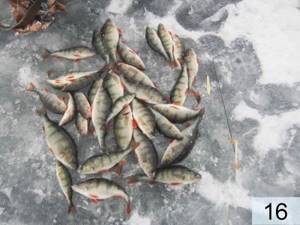
There are days when the perch is inactive, bites with a weak blow and is caught at the very tip of the lip. With such a bite and fishing at great depths, the perch can hang on the spoon after the next stroke without a noticeable bite. Don’t be lazy to sit down or bend over to take the fish from the hole itself (photo 11).
Spinner design with chain
A spinner with a chain is an ordinary small spinner, at the end of which, instead of a hanging tee or soldered hooks, there is a small chain with a hook or jig at the end. The usual length of such a chain is from 3 to 7 cm. It may be a little more or less. It all depends on the spinner and the manufacturer. But usually the average length of the chain is 4-5 cm.
The chain can be firmly attached to the spinner through a winding ring, or even in a homemade version it can be soldered. But in most cases, fastening is done through a special small latch without a lock. This is necessary for quickly changing the chain while fishing right on the pond. He fiddles with the winding rings for a long time. Especially in winter. And with a soldered-in replacement it won’t work at all. You will have to change the entire bait.
The hooks on the chain are most often single. Sometimes they are decorated with wool or beads of different colors. If there are no such artificial baits, then fishermen often modify the design themselves and add something of their own to the hook.
Sometimes single hooks are replaced with triple ones. The tee has a greater chance of catching fish, but there is also a greater chance of the bait catching on the grass or debris on the bottom. Tees are also often supplemented with beads, or wool is wound. This helps to better attract fish to such bait.
Instead of hooks, a medium-sized jig can be suspended at the end of the chain. The colors of the jig can be very different. There are even phosphor-coated jigs that glow in the dark water of reservoirs or in deep places. Mormyshki can be not only one color, but also multi-colored. And on the hook of the jig, wool can also be wound, or multi-colored beads can be worn. Instead of beads, anglers sometimes independently use cambric, artificial bloodworms, or maggots.
At the upper end of the spoon there is a hole through which it is hooked to the main fishing line. Sometimes a winding ring is additionally placed in the hole for ease of suspension. This is a controversial decision, since such a ring can change the game of the bait. Instead of a movably hanging ring, sometimes there are designs with a soldered loop. This design is much more convenient and does not have any effect on the play of the spinner. In addition to the ring, you can also find an additional swivel. But it can also have a negative impact on the game and it is better to avoid it. Moreover, many fishermen place a carabiner with a swivel at the end of the fishing line. So another swivel on the spoon itself will simply be superfluous.
Ichthyological nuances of fishing
It often happens that schools of medium-sized Ladoga perches bite better on jigs from the bottom, they are caught in crowds, and the spinners have no bite. I noticed that jigs are more often seduced by light-colored perches, with clearly defined narrow stripes on the light sides and bright orange-red fins (photo 12). This perch is inactive; the echo sounder shows that it is standing at the bottom (photo 13). This kind of perch rarely bites on large solders, preferring small spoons with a hanging hook or balancers.
There is a subspecies of perch in Ladoga that is dark green in color with dull stripes and dull blood-red fins (photo 14). It was possible to catch such perches in the same water area and on the same day when most of the anglers in the crowd were fishing with bloodworms. Most often, these perches are caught further than two to three kilometers from the shore and away from the crowd. Often, while the first of these perches is spinning around the spoon, several more join it - and on the echo sounder screen, the entire space under the hole is filled with signals from the fish (photo 15). And then several fish come across at once.
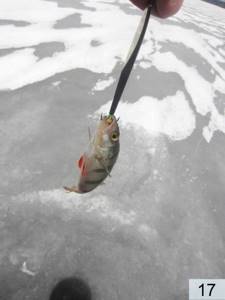
In the absence of bites on Ladoga, soldering is best for catching deep dark perch. On a flat bottom landscape, this species prefers places where there is a slight depression compared to the surrounding depth background.
And there are days when Ladoga pleases lure anglers with such a bite, when perches of all colors come across the bait (photo 16).
In the Gulf of Finland, it is better to catch fish in the water area behind the Dam. There the perch is so predatory that you often come across a “sailor fish” the size of a spinner (photo 17). The soldered ones on the southern coast of the Gulf of Finland are especially catchy.
Diving spoons
They are used mainly in winter, although sometimes they are caught in summer. This is possible from boats, rafts, dams in areas where horizontal movement of the spoon is impossible, for example, among the logs of old mills, support and snags, hydraulic structures, etc. In these places, pike perch and perch take diving lures. On the Volga in summer it is quite possible to fish with a winter lure from the side of a boat. When trolling vertically, sabrefish, pike perch, herring, silver bream and bleak are caught. Similar fishing, even from the side of a vessel moored at the pier, can be quite productive. An interesting experience of using a spoon for vertical trolling was described at one time by amateur fisherman A. Mytarev. Having become acquainted with this type of vertical lure on Lake Akatovskoe, he calls it “Akatovsky lure.” It is characterized by long-distance casting of the spoon for vertical trolling and spasmodic retrieval with periodic touches to the bottom. Diving spoons have, so to speak, a classic contour. Usually these are elongated metal plates in the shape of a fry. To ensure minimal play and ensure that their movement is not linear, several techniques are used. The plates are either bent in a special way, or all kinds of soldering with heavy metals are done away from the axis of symmetry, or the places where the fishing line and hooks are attached are shifted. All this makes it difficult to move the bait in the water column, making it look like the movement of an unhealthy or injured fish. In the trade you can find quite good spinners of the given type, so starting a decent collection of lures for ice fishing will not be difficult.
The novice angler is convinced: by simply plunging the spoon and sharply pulling it out of the water, he does what is necessary. Fishing with a vertical spoon is not so easy. Even the most catchy of these baits requires specific knowledge and skills. This must be learned, including at the hole. Carefully study the nature of its movement when immersed in water, pulling up, stopping. This is all the more important because even 2 spinners from the same stamp show different personalities when driven under the ice. It is necessary to select baits in your fishing luggage that do not just go to the bottom, tumble and flicker. Only spinners that tilt along smooth trajectories that go far away from the hole demonstrate good performance. The catchers are spoons, as if prowling as they sink to the bottom. The characteristics of a particular bait, correctly applied by the angler when developing his own fishing pattern, guarantee success. For example, if the spinner makes a correct sliding movement in one direction, it is necessary to create a 45° turn with the body every 1-2 casts when spinning. This will allow you to catch the entire area close to the hole.
Soldering care
- When purchasing soldered hooks, immediately put small polyurethane covers on the hooks so that the tips do not become dull during storage and transportation. If you changed the lure during fishing, put the solder in the box with the pads on the tip, don’t be lazy.
- Check the condition of the hook tip frequently. Carry with you a file or a special sharpener for hooks to straighten the tip if it breaks at the tip or is bent.
- To strip the metal of the spinner from the patina, buy an eraser with a hard part for erasing the paste of a fountain pen. You may need a piece of felt or thick flannel with GOI paste applied. It is not necessary to polish the metal to a mirror shine; I rub it so that when I play the lure at a shallow depth, I can see the reflections from it in the water.
- Some non-ferrous metals and alloys form galvanic couples when they come into contact in a wet state, and the contact surface is covered with oxides. Therefore, store soldered joints so that the metal edges of different spinners do not touch.
- And keep the spinners dry.
- Solders are better than other spinners and balancers in being detached from snags using a detacher with a wire loop.
Soldering the loop of a winter spinner
Soldering a loop into the nose end, or into the “tail” of the body, which serves to tie the winter bait to the fishing line, for me personally is the last operation of making a spinner and is done before finishing the homemade body.
To solder the loop, we apply a twist of wire to the tail end of the spinner, and use a soldering iron to heat the layer of solder that was previously poured under the loop.
If you are soldering light winter perch spinners with a thin fill of the petal with solder, then before installing the loop at the end of the homemade spinner, the twisted wire can be ground off a little in the plane of the opening of the ring or flattened on a plate with a hammer.
Hooks on lures
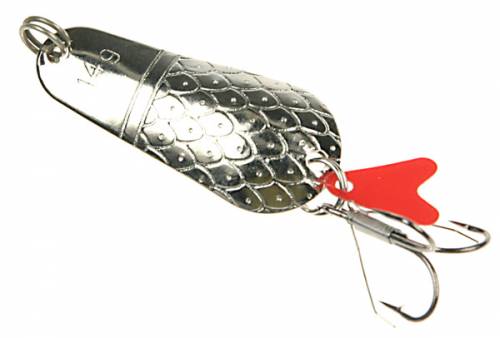
There are perch spoons with a single or double hard-soldered hook. When the bite is bad, baits with free hooks help out. For example, suspended on a ring or on a chain.
But they have both their pros and cons. For example, a single, hard-soldered one makes play clear and does not create interference. But when removing fish from a double hook, you will have to tinker a little. Suspended, with a ring attachment, it can itself attract a predator. But a hook suspended on a chain attracts a striped fish from long distances.
